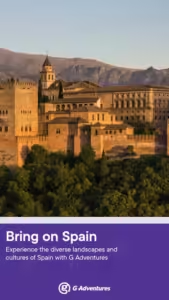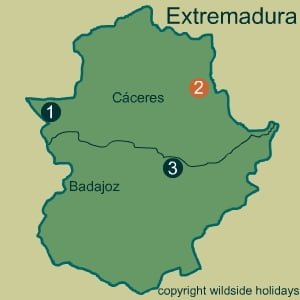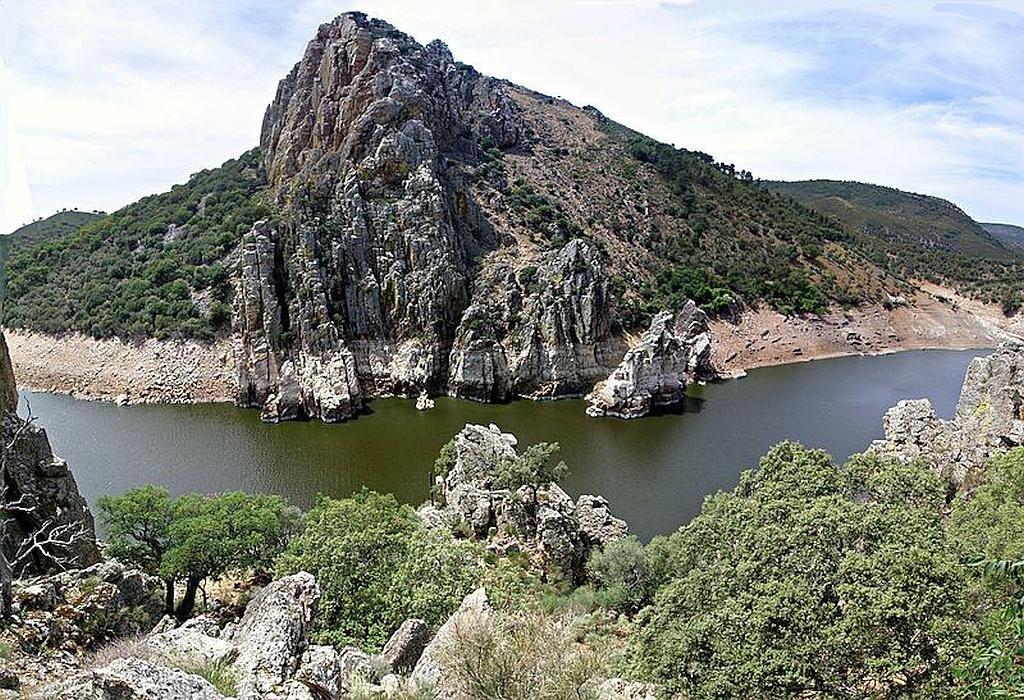Walking and wildlife holidays in Extremadura
- Capital: Merida
- Area: 41,602 km²
- Provinces 2: Cáceres, Badajoz

One of Spain’s most sparsely populated regions which makes it a wonderful area to study the nature and visit the Natural parks in Extremadura.
The landscape is shaped by the mountain ranges of the Cordillera Central, Montes de Toledo and the Sierra Morena (which is on its southern border with Andalucia). Fertile plains surround the large bodies of water supplied by the Tajo river in Caceres and the Guadiana in the low lands of Badajoz.
White storks have a massive population in this area, with possibly around 11,000 individuals. Their huge nests can be seen perched around church steeples, roofs and atop telegraph poles. Other birds for which Extremadura is well known are the Great and Little Bustards which live on the extensive plains.

Extremadura has one National Park, the National Park of Monfragüe. The valleys of its two rivers are important ecological reserves and are excellent areas to observe many raptors. It is one of the best areas to see Black vultures, Black storks and Imperial eagles.
Find accommodation close to Monfragüe National Park over at Booking.com
Dehesas are farms that blend a mixture of agriculture, raising livestock, set aside and tree plantations. Large oak trees are widely spaced, these may have grazing animals, crops beneath or just be rested meadow land. This combination offers an ideal habitat for many wild birds, wild flowers and creatures such as the large Oscillated lizard. The acorns supply a food source for Cerdo Ibérico (black Iberian pig).
A few sights and sounds from Extremadura by Juan Frutos
This region of Extremadura comprises of two provinces, Caceres and Badajoz, its capital nevertheless being Merida. The capital is certainly worth a visit to view its fantastic Roman ruins. Romans put Extremadura on the stage of history, and Merida was one of the most important cities in the whole Roman Empire. Later on the region was, for a long period of time, the border between Moorish and Christian Spain.
After the Reconquista, Extremadura entered a new era of splendor during the Age of Exploration. The region became known as the cradle of several of Spain’s most influential conquistadors—men who played key roles in the Spanish colonization of the Americas. Among them were Hernán Cortés, who led the expedition that toppled the Aztec Empire in Mexico, and Francisco Pizarro, who conquered the Inca Empire in Peru. Others, such as Pedro de Valdivia and Núñez de Balboa, also hailed from Extremadura and were instrumental in expanding Spanish influence across South America. This wave of exploration and conquest brought immense wealth and prestige to Spain and left a lasting historical legacy tied closely to Extremadura’s identity.
Tours in Extremadura from Viator
Extremadura has a vast array of sites to visit and enjoy. Below are some of the options listed on the Viator website. (We recieve a small commission if you book a tour which doesn’t cost you more and helps us to keep Wildside Holidays up to date with the best information.)
Natural parks in Extremadura

The capital, Mérida, is known for Roman ruins of Augusta Emerita, including the Teatro Romano, Circo Romano, aqueducts and a bridge over the Guadiana River.
Extremadura has two Natural Parks and one National Park.
1 Tajo international Natural Park The Tajo International natural park is a relatively recently registered park in Extremadura which was initially partly covered by an area of special protection for birds ZEPA in 2000.
2 Monfragüe National Park The area of Monfragüe National Park is noted for its importance as a breeding area for a selection of rare and protected birds, Black vulture, Black stork, Imperial eagle and Bonelli’s eagle. Add to that the worlds most endangered wild cat, the Lynx which also resides here and one can see why it was upgraded from a natural to a national park. Find accommodation close to Monfragüe National Park over at Booking.com
3 Cornalvo and the Sierra Bermeja Natural Park Consists mainly of oak dehesas, (open oak woodland rotated with pasture and cereal crops) on rolling hills with the small mountain ranges of the Sierra del Moro and Sierra Bermeja on the western flank. The highest point is “Pico Terrero” at 546 m above sea level.
The stunning scenery in Extremadura
Other interesting areas in Extremadura
The dehesas of Extremadura. The region of Extremadura is about the same size as Switzerland and is made up of two large, sparsely-populated provinces – Cáceres and Badajoz. Passing through Extremadura you may well encounter areas containing splendid oak trees. They appear at first glance to be a natural landscape with majestic trees scattered over rolling hills, but in fact they are carefully cultivated and managed. This is the dehesa of Extremadura.
5 Natural monuments in Extremadura. Apart from some fantastic natural parks there are quite a few other places to visit such as the 5 natural monuments in Extremadura (Monumentos naturales de Extremadura)
Located in the extreme north-east of the province, the Valle del Jerte in Extremadura is bordered to the north by the provinces of Ávila and Salamanca, to the west by Valle del Ambroz, to the south by the city of Plasencia and to the east by La Vera. The area has become quite famous for the beauty of its cherry tree orchards in spring and for the Garganta de los Infiernos Nature Reserve.
FAQ: Nature and Wildlife in Extremadura, Spain
Extremadura is one of Spain’s least populated regions, covering over 41,000 km² across Cáceres and Badajoz. Its varied terrain—shaped by the Cordillera Central, Montes de Toledo, Sierra Morena, and the Tajo and Guadiana rivers—offers rich biodiversity. The low human footprint allows wildlife to thrive, making it a haven for naturalists, birdwatchers, and hikers.
A dehesa is a traditional agro-silvopastoral system unique to Iberia, especially prominent in Extremadura. It features widely spaced oak trees (mainly holm and cork) over pasture or cropland. These oak groves support grazing animals, wildflowers, reptiles like the Ocellated lizard, and large bird populations. Dehesas also play a vital role in the economy by producing acorns that feed the prized Cerdo Ibérico (black Iberian pig).
Extremadura is one of Europe’s top birdwatching regions. White storks are iconic, often nesting on rooftops and bell towers. Open plains host Great and Little Bustards, while Monfragüe National Park shelters rare raptors such as Black vultures, Spanish Imperial eagles, Bonelli’s eagles, and Black storks. Crane migration in winter is another highlight, especially near La Serena.
Monfragüe National Park: A prime raptor habitat and one of the best places in Europe for birdwatching.
Tajo Internacional Natural Park: A cross-border reserve along the Tagus River, partially designated as a Special Protection Area (ZEPA).
Cornalvo Natural Park: Home to Roman-era reservoirs and dehesa landscapes.
Sierra de San Pedro and Sierra Bermeja: Rich in Mediterranean forest and protected bird zones.
Garganta de los Infiernos Reserve: Located in Valle del Jerte, famous for glacial pools and cherry blossoms.
Los Barruecos Natural Monument: Known for granite formations and Europe’s largest stork colony.
Yes, though still rare, the Iberian Lynx has been reintroduced into parts of Extremadura. Monfragüe and the Sierra de Hornachos are among the potential sighting zones. The species is one of the world’s most endangered wild cats, and ongoing conservation efforts are helping to restore its habitat.
Extremadura is rich in Roman and Moorish heritage. Mérida (Augusta Emerita), a UNESCO World Heritage Site, offers exceptional Roman ruins like the theater, circus, and aqueduct. Medieval towns such as Trujillo and Cáceres blend historical architecture with cultural charm, making them ideal for combining nature and heritage in one trip.
Hiking, birdwatching, wildlife photography, and river-based activities are popular. Marked trails wind through Monfragüe, Tajo Internacional, and the Valle del Jerte. Spring cherry blossoms, autumnal bird migrations, and year-round sunshine make it a perfect slow-travel destination.
About the author of this article.
I’ve been living in this lovely area of Western Andalucia for the last 20 years or so and dedicate most of my time to the running of English language tourist information websites for the towns of Cádiz, Ronda, Grazalema, the famous or infamous Caminito del Rey, and also Wildside Holidays, which promotes sustainable and eco-friendly businesses running wildlife and walking holidays in Spain.

